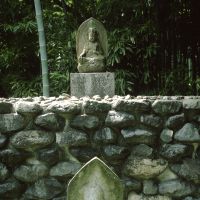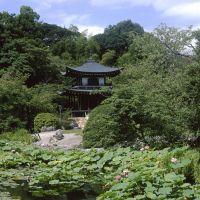On my first visit to the ancient pond garden of Kajuji, it took me a devil of a time just to locate it. Alighting at Ono, a subway stop on Kyoto's Tozai line, there was nothing to suggest the area might be of interest to visitors, that it could have any serious historical or cultural credentials.
After a well-meaning local pointed me in the wrong direction, I was obliged to retrace my steps back to the station. The confusion was due partly to the fact that the garden is little known, even to some of the residents of this quarter of southeast Kyoto. To further complicate matters, the bifurcating etymology of the temple includes the common rendering Kanshuji, as well as the more familiar Kikki-san. Garden authority and Kyoto resident Gunter Nitschke refers to the garden as Kanjuji.
My original source for the site was the book "The Lure of the Japanese Garden," a useful anthology of sites, in which the Australian authors Alison Main and Newell Platten write of a landscape so rich in plantings that "much of the garden now appears a natural setting rather than an artifice." The effort in finding such a promising place turned out to be well worth it, and the relative obscurity of the garden meant I had it almost entirely to myself.
The original grounds of Kajuji contained a much larger pond and hill garden, built on the estate of Iemasu Miyamachi, a Heian Period aristocrat connected by marriage to the powerful Fujiwara family. Around the year 900, the grounds were converted into a temple at the behest of the Emperor Daigo, who appears to have had a fondness for the area because of its association with his mother, a long-term habitue. The original landscape would have been located just outside the city. Even today, with glimpses of rice fields and mountains between the roadways, shops and residential blocks, the area has a semi-rural feel.
Buddhist priests of aristocratic or imperial lineage, known as monzeki, served at the temple. Its clergy also included princes of the imperial line, who lived at Kajuji as monks. Like many sacred sites in Kyoto, Kajuji was raised to the ground in 1470 during the merciless Onin War. Removed from politics, and only subtly linked to religious doctrine, the outline and form of the garden survived.
There seem to be two components that can help to preserve the configuration of a garden: its rocks and pond. These are likely to have more staying power than plantings or man-made features such as teahouses and pergolas. Kajuji is one of the few gardens in Japan that contains visible traces of the Heian Period garden type known as chisen shūyū teien, or the "pond-spring-boating garden".
Known among garden cognoscenti for a single February-blooming plum tree, transplanted directly from the Imperial Palace, high summer, when the garden's lotuses are in full bloom, is the ideal time to visit Kajuji.
A miniature world of water and greenery, the pond at Kajuji is an exuberant breeding tank for all manner of aquatic and bird life, from kingfishers and herons to the swarm of minnows that feed them. The 200-meter-long pond also hosts a great number of water lilies. The two aquatic flowers blend so seamlessly, it is difficult at first glance to see where one starts and the other ends. The flowers are often mixed up, even among the Japanese, who have more exposure to them. Where the flowers of the lotus float above the water line, the blossoms and pads of the water lily, a spikier flower with a different color range, sit on the surface. Where the lotus is at its best in the early morning, the water lily blooms throughout the day.
There is a lesson of self-improvement, a parable almost, in the evolution of the lotus, its roots entrenched in the slime and mud of this imperfect world, its leaves and flowers rising heavenward. The plant's fleshy pink blossoms, rising between floating divans of green leaf, evoke the "jewel in the lotus" of the Buddhist sutras.
Returning to Kajuji, I'm always reminded of a haiku by the poet Masaoka Shiki: "Raindrops/And dewdrops roll around and meet/On the lotus." This most exotic of Oriental flowers has always impressed writers and other creative people. On a trip through Japan in 1958, the author Sacheverell Sitwell, contemplating the wonders of the flowers growing in Ueno's Shinobazu Pond, saw "a lake covered with magnificent lotuses so huge that, unknowing, one would take them for giant, but mysteriously beautiful cabbages of unknown Oriental strain." The great film auteur Akira Kurosawa heard it said that when lotuses bloom they make a clear popping sound. "So one morning," he wrote in his autobiography, "I got up very early and trekked to Shinobazu Pond in Ueno to listen to the lotuses opening. And in the dim mists of morning I heard that sound."
Aside from its aesthetic qualities, the flower has several uses. Its pods and roots are edible, and in several countries, particularly humid ones such as Vietnam, lotus tea serves as a refreshing brew. Some teahouses in the Edo Period (1603-1867) that were located on the edge of ponds specialized in steamed rice wrapped in lotus leaves. Customers could sit on verandas and enjoy the view.
The history of Kajuji suggests a less commercialized, more refined role. Despite its association with lotuses, a flower that thrives in the extreme humidity of Kyoto summers, the garden's central component is the pond itself. Known as Himuro (Icehouse) Pond, it was once used for leisurely boating and as a venue for poetry-writing parties. The pond also had a more serious, less recreational function: In a city noted for its bitter winters, officials undertook an annual visit to the garden on Jan. 2 to remove ice from the pond and carry it to the imperial court, where it was subjected to a ritual examination. The thickness of the ice would divine the success or otherwise of the next grain harvest.
There are four immediately visible layers to this intriguing garden. The edges of the pond contain a mass of foreground plantings that include irises; the eye is then drawn to the pond, with its second tier of water plants. A tree line at the rear of the garden forms the third feature, helping to define the composition of the first two elements. The fourth level is Mount Daigo, a densely forested mountain that is both a borrowed view and a barrier to whatever unnatural features might lie beyond it.
Visitors during the summer months are drawn back to the pond and its lotus plants, and the garden's resemblance to the Buddhist Pure Land. In his short story "The Priest and His Love," writer Yukio Mishima claimed, "The lotus flower can become the foundation for an entire theory of the universe and an agent whereby we may perceive Truth." Most visitors to Kajuji are content to simply sit on a bench at the water's edge and experience the calm, transforming quality of the flowers.
Nearest station: Ono (Tozai Line); 10-minute walk from the rear of the station. (075) 571-0048. Open 9 a.m.-4 p.m. Entrance fee: ¥400. Stephen Mansfield's new book, "Japan's Master Gardens: Lessons in Space and Environment," was published this spring. He will be giving a talk on the book at Good Day Books ([03] 6303-9116) in Gotanda, Tokyo, on Sept. 16.




